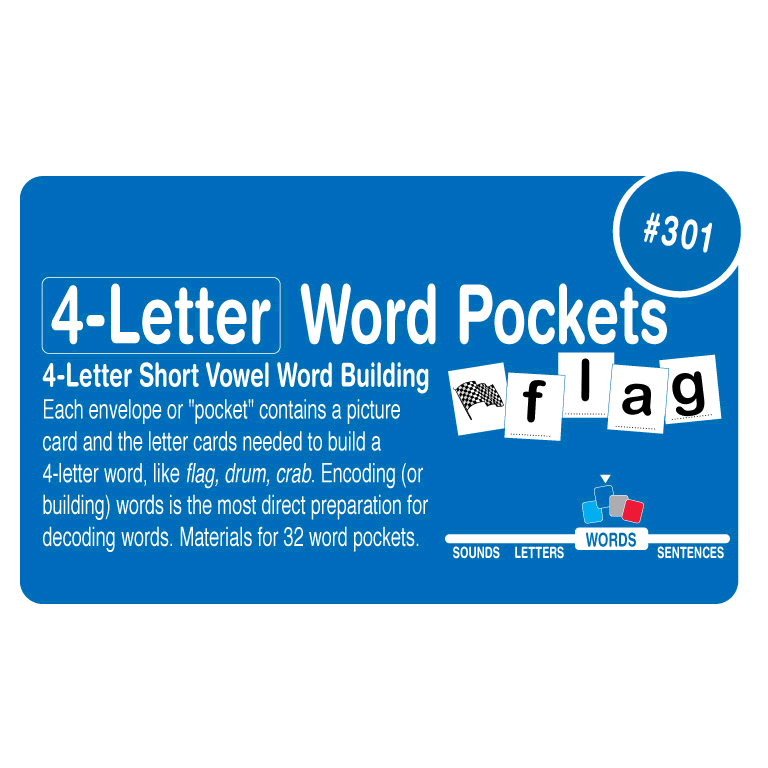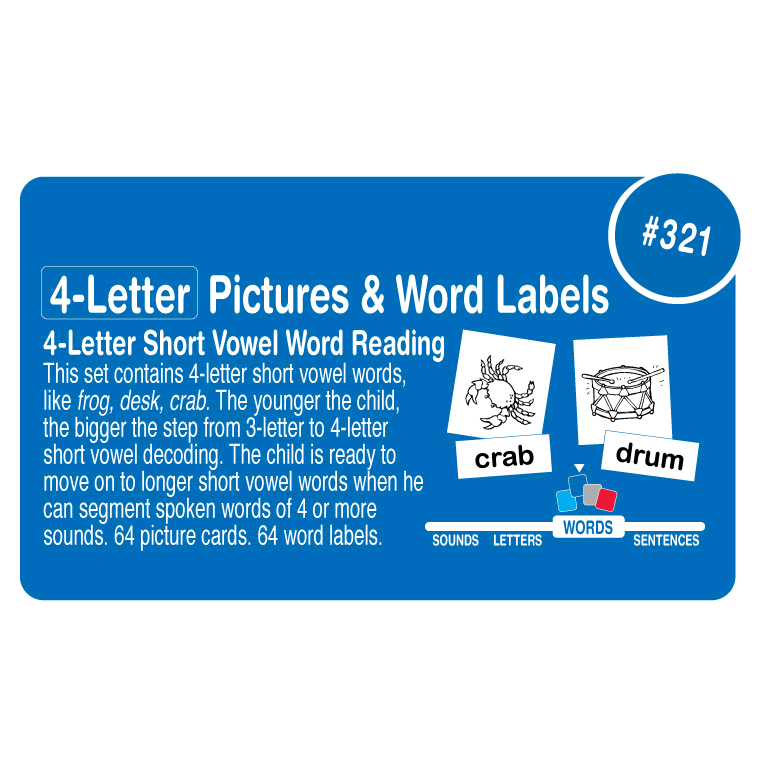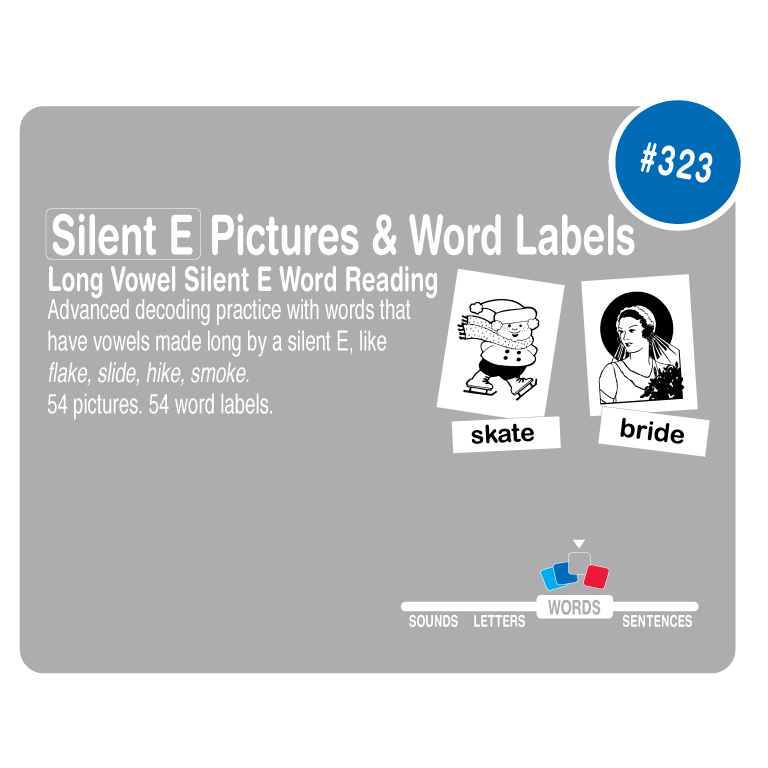Decoding & Word Identification
The foundation of comprehension is accurate word recognition. Skillful readers decode rapidly and automatically. Reading problems occur primarily at the level of single word recognition—which begins with the ability to decode.
Introduce encoding as preparation for decoding.
With word building materials, the child first segments a word into sounds. Then, as he speaks the sounds, he places the letters one at a time in proper sequence to form the printed word. This is a perfect introduction to reading because encoding words is the best way for a beginning reader to learn about decoding words. Don’t think of this activity as spelling, though. It is word building and is meant to show how printed and spoken words map onto each other. This is the understanding of the alphabetic principle at the word level. Word Pockets allow the non-writing child to have repeated success building words he will soon be ready to read. Note: we begin with 3-letter words because that matches the child’s level of segmentation (3 sounds).
[3-Letter] Word Pockets
Short Vowel Word Building
Price: $15.00
Item #300
Each envelope or “pocket” contains a picture card and 3 letter cards needed to build a short vowel word, like cup, bug, web. Encoding (or building) words is the most direct preparation for decoding words. Materials for 32 word pockets.
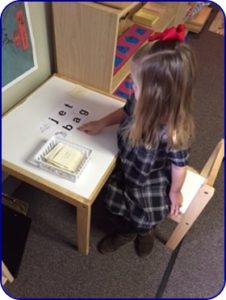
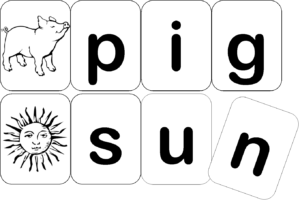
Continue reading →
Each envelope or “pocket” contains a picture card and 3 letter cards needed to build a short vowel word, like cup, bug, web. Encoding (or building) words is the most direct preparation for decoding words. Materials for 32 word pockets.


Continue reading →
[4-Letter] Word Pockets
Short Vowel Word Building
Price: $15.00
Item #301
Each envelope or “pocket” contains a picture card and the letter cards needed to build a 4-letter word, like flag, drum, crab. Encoding (or building) words is the most direct preparation for decoding words. Materials for 32 word pockets.
 Continue reading →
Continue reading → Each envelope or “pocket” contains a picture card and the letter cards needed to build a 4-letter word, like flag, drum, crab. Encoding (or building) words is the most direct preparation for decoding words. Materials for 32 word pockets.
 Continue reading →
Continue reading → [Silent E] Word Pockets
Long Vowel Word Building
Price: $15.00
Item #302
Each envelope or “pocket” contains a picture card and the letter cards needed to build a long vowel silent E word, like flame, smoke, cake. Materials for 32 word pockets.
 Continue reading →
Continue reading → Each envelope or “pocket” contains a picture card and the letter cards needed to build a long vowel silent E word, like flame, smoke, cake. Materials for 32 word pockets.
 Continue reading →
Continue reading → [Phonogram] Word Pockets
2-Letter Phonogram Word Building
Price: $15.00
Item #303
Each envelope or “pocket” contains a picture card and the letter cards needed to build a word containing a 2-letter phonogram, like goat, snail, feet, horn, ship. Materials for 32 word pockets.
 Continue reading →
Continue reading → Each envelope or “pocket” contains a picture card and the letter cards needed to build a word containing a 2-letter phonogram, like goat, snail, feet, horn, ship. Materials for 32 word pockets.
 Continue reading →
Continue reading → [5 & 6-Letter] Word Pockets
Short Vowel Word Building
Price: $15.00
Item #305
Each envelope or “pocket” contains a picture card and the letter cards needed to build a 5- or 6-letter short vowel word, like plant or insect. Encoding is the most direct preparation for decoding words. Materials for 32 word pockets.
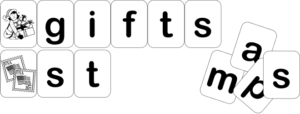 Continue reading →
Continue reading → Each envelope or “pocket” contains a picture card and the letter cards needed to build a 5- or 6-letter short vowel word, like plant or insect. Encoding is the most direct preparation for decoding words. Materials for 32 word pockets.
 Continue reading →
Continue reading → Introduce decoding.
A child’s first reading material should connect a picture with a 3-letter short vowel word. This allows the child to “map” the 3 sounds of a spoken word (which she gets from segmenting the picture) onto the printed word. The child thus learns about left-to-right decoding and word identification. Once the child is familiar with a set of Standup Word Cards, she can be shown to hide the picture, decode the word and then flip it back to see if she got it right. This first independent “reading” is always successful and will give the child confidence as she moves forward into more challenging reading levels. Note: Introduce The Blending Game Set 2 [4 Sounds] to prepare the child to decode 4-letter words.
[3-Letter] Standup Word Cards
Short Vowel Decoding
Price: $12.00
Item #310
Material for making the child’s first reading a success. The child is encouraged to “map” the sounds of the picture (which represents a spoken word) onto the printed 3-letter short vowel word and thus learns about decoding and word identification. Examples: van, sun, dog, cup. 45 Cards.

 Continue reading →
Continue reading → Material for making the child’s first reading a success. The child is encouraged to “map” the sounds of the picture (which represents a spoken word) onto the printed 3-letter short vowel word and thus learns about decoding and word identification. Examples: van, sun, dog, cup. 45 Cards.

 Continue reading →
Continue reading → [4-Letter] Standup Word Cards
Short Vowel Decoding
Price: $12.00
Item #311
This set contains cards with 4-letter short vowel words, like drum, tent, gift, desk. 4 letters is slightly more difficult than 3 letters, therefore a child must first be able to segment and blend spoken words that have 4 sounds. 44 Cards.
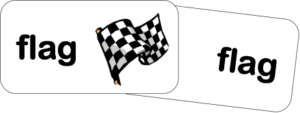
 Continue reading →
Continue reading → This set contains cards with 4-letter short vowel words, like drum, tent, gift, desk. 4 letters is slightly more difficult than 3 letters, therefore a child must first be able to segment and blend spoken words that have 4 sounds. 44 Cards.

 Continue reading →
Continue reading → [Silent E] Standup Word Cards
Decoding the Silent E
Price: $12.00
Item #312
This set contains words that have vowels made long by a silent E, like smoke, flame, cake, kite, globe. The picture on the card allows the child to map the sounds of the spoken word onto the printed word, leading to an understanding of this new spelling pattern. 48 cards.
Continue reading →This set contains words that have vowels made long by a silent E, like smoke, flame, cake, kite, globe. The picture on the card allows the child to map the sounds of the spoken word onto the printed word, leading to an understanding of this new spelling pattern. 48 cards.
Continue reading →[Phonogram] Standup Word Cards
Decoding 2-Letter Phonograms
Price: $12.00
Item #313
This set contains words that have 2-letter phonograms, like goat, snail, feet, horn, ship. The picture on the card allows the child to map the sounds of the spoken word onto the printed word, leading to an understanding of the new spelling pattern. 48 cards.
Continue reading →This set contains words that have 2-letter phonograms, like goat, snail, feet, horn, ship. The picture on the card allows the child to map the sounds of the spoken word onto the printed word, leading to an understanding of the new spelling pattern. 48 cards.
Continue reading →[5 & 6-Letter] Short Vowel Word Cards
Price: $12.00
Item #314
Advanced decoding practice with 5 and 6-letter short vowel words, like robin, sunset, plant. Encourage the student to first segment the sounds of the picture and “map” those phonemes onto the printed letters. This will lead to an understanding of the new spelling pattern. He can then practice decoding the word without the picture until he achieves automatic word recognition. 42 word cards.


Continue reading →
Advanced decoding practice with 5 and 6-letter short vowel words, like robin, sunset, plant. Encourage the student to first segment the sounds of the picture and “map” those phonemes onto the printed letters. This will lead to an understanding of the new spelling pattern. He can then practice decoding the word without the picture until he achieves automatic word recognition. 42 word cards.


Continue reading →
Dolch Nouns
High-Frequency Words Decoding Mastery Game
Price: $12.00
Item #318
Advanced decoding practice with high frequency Dolch words like children, table, boy, girl. Encourage the student to first segment the sounds of the picture and “map” those phonemes onto the printed letters. This will lead to an understanding of the new spelling patterns. He can then practice decoding the word without the picture until he achieves automatic word recognition. 48 word cards.
Continue reading →Advanced decoding practice with high frequency Dolch words like children, table, boy, girl. Encourage the student to first segment the sounds of the picture and “map” those phonemes onto the printed letters. This will lead to an understanding of the new spelling patterns. He can then practice decoding the word without the picture until he achieves automatic word recognition. 48 word cards.
Continue reading →Provide lots of decoding practice.
More than anything else, the beginning reader needs lots of practice decoding words that match his ability level. With short vowel pictures and word labels, the child may still refer to the picture for phonemic clues as to which label to choose. But with practice he will soon reach a more mature level of decoding where he simply takes a label, decodes it and places it beneath the correct picture. Ideally the learning environment will provide 20 or 30 sets of pictures and labels the child can work through to become a confident decoder at each level of difficulty (Short Vowel [3-letter, 4-letter, multi-syllable], Silent E, Phonogram).
[3-Letter] Pictures & Word Labels
Short Vowel Decoding Practice
Price: $8.00
Item #320
This set contains 3-letter short vowel words, like van, cup, elf. The child can match the word label to a picture by using his phonemic awareness to figure out the sounds in the word he’s looking for. Or he can simply decode the printed letters into sounds and place the label beneath the correct picture. 64 picture cards. 64 word labels.
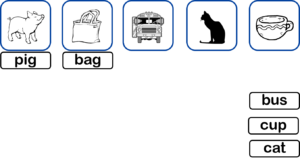 Continue reading →
Continue reading → This set contains 3-letter short vowel words, like van, cup, elf. The child can match the word label to a picture by using his phonemic awareness to figure out the sounds in the word he’s looking for. Or he can simply decode the printed letters into sounds and place the label beneath the correct picture. 64 picture cards. 64 word labels.
 Continue reading →
Continue reading → [4-Letter] Pictures & Word Labels
Short Vowel Decoding Practice
Price: $8.00
Item #321
This set contains 4-letter short vowel words, like frog, desk, crab. The younger the child, the bigger the step from 3-letter to 4-letter short vowel decoding. The child is ready to move on to longer short vowel words when he can segment spoken words of 4 or more sounds. 64 picture cards. 64 word labels.
 Continue reading →
Continue reading → This set contains 4-letter short vowel words, like frog, desk, crab. The younger the child, the bigger the step from 3-letter to 4-letter short vowel decoding. The child is ready to move on to longer short vowel words when he can segment spoken words of 4 or more sounds. 64 picture cards. 64 word labels.
 Continue reading →
Continue reading → [5 & 6-Letter] Pictures & Word Labels
Short Vowel Decoding Practice
Price: $8.00
Item #322
Advanced decoding practice with 5 & 6-letter short vowel words, like, plant, stamps, gifts, and multi-syllable short vowel words like robin, pumpkin, camel. 54 picture cards. 54 word labels.
Continue reading →Advanced decoding practice with 5 & 6-letter short vowel words, like, plant, stamps, gifts, and multi-syllable short vowel words like robin, pumpkin, camel. 54 picture cards. 54 word labels.
Continue reading →[Silent E] Pictures & Word Labels
Silent E Decoding Practice
Price: $8.00
Item #323
Advanced decoding practice with words that have vowels made long by a silent E, like flake, slide, hike, smoke. 54 picture cards. 54 word labels.
Continue reading →Advanced decoding practice with words that have vowels made long by a silent E, like flake, slide, hike, smoke. 54 picture cards. 54 word labels.
Continue reading →[Phonogram] Pictures & Word Labels
2-Letter Phonogram Decoding Practice
Price: $8.00
Item #324
Advanced decoding practice with words that have 2-letter phonograms like, cloud, lunch, boat, jeep, bird. 72 picture cards. 72 word labels.
Continue reading →Advanced decoding practice with words that have 2-letter phonograms like, cloud, lunch, boat, jeep, bird. 72 picture cards. 72 word labels.
Continue reading →[3-Letter] Word Choice Reading Game
More Short Vowel Decoding Practice
Price: $8.00
Item #330
Each card contains a picture of a 3-letter word like, fox, pig, gum. Beneath each picture are 3 word choices. The child won’t get fooled if he uses his segmentation skill and maps all 3 sounds of the spoken word onto the correct printed word. 54 cards.
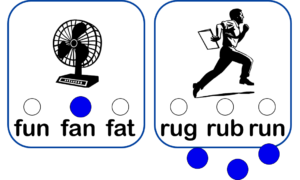
Continue reading →
Each card contains a picture of a 3-letter word like, fox, pig, gum. Beneath each picture are 3 word choices. The child won’t get fooled if he uses his segmentation skill and maps all 3 sounds of the spoken word onto the correct printed word. 54 cards.

Continue reading →
[4-Letter]Word Choice Reading Game
More Short Vowel Decoding Practice
Price: $8.00
Item #331
Each card contains a picture of a 4-letter word like, desk, tent, pond. Beneath each picture are 3 word choices. The child won’t get fooled if he uses his segmentation skill and maps all 4 sounds of the spoken word onto the correct printed word. 48 cards.

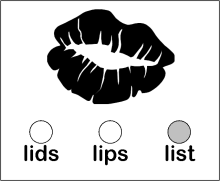 Continue reading →
Continue reading → Each card contains a picture of a 4-letter word like, desk, tent, pond. Beneath each picture are 3 word choices. The child won’t get fooled if he uses his segmentation skill and maps all 4 sounds of the spoken word onto the correct printed word. 48 cards.

 Continue reading →
Continue reading → 5 & 6 Letter Short Vowel Word Choice Reading Game
5 & 6 Letter Short Vowel Word Choice Reading Game
Price: $8.00
Item #335
Each card contains a picture of a 5 or 6-letter short vowel word like, plant, clamp trunk, robin. Beneath each picture are 3 word choices. A game piece (not included) is placed above the correct answer. The student’s phoneme segmentation skill can help him find the right word and allow him to check his work. 48 cards.
Continue reading →Each card contains a picture of a 5 or 6-letter short vowel word like, plant, clamp trunk, robin. Beneath each picture are 3 word choices. A game piece (not included) is placed above the correct answer. The student’s phoneme segmentation skill can help him find the right word and allow him to check his work. 48 cards.
Continue reading →[Silent E] Word Choice Game
Word Choice Decoding Game
Price: $8.00
Item #336
Each card contains a picture of a silent E word like, rope, bride, dive. Beneath each picture are 3 word choices. The beginning reader uses his segmentation skills to map all of the sounds of the spoken word onto the correct answer. 54 cards.
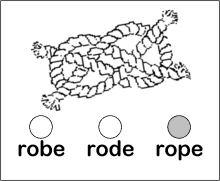
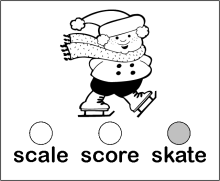 Continue reading →
Continue reading → Each card contains a picture of a silent E word like, rope, bride, dive. Beneath each picture are 3 word choices. The beginning reader uses his segmentation skills to map all of the sounds of the spoken word onto the correct answer. 54 cards.

 Continue reading →
Continue reading → Phonogram Word Choice
Word choice decoding game
Price: $8.00
Item #337
Each card contains a picture of a phonogram word like, boat, bird, snow, feet. Beneath each picture are 3 word choices.
The beginning reader uses his segmentation skills to map all of the sounds of the spoken word onto the printed words beneath to find the correct answer.
48 cards.
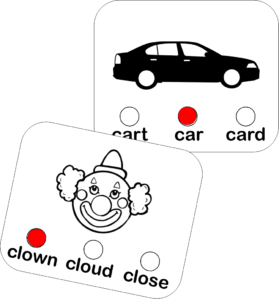 Continue reading →
Continue reading → Each card contains a picture of a phonogram word like, boat, bird, snow, feet. Beneath each picture are 3 word choices.
The beginning reader uses his segmentation skills to map all of the sounds of the spoken word onto the printed words beneath to find the correct answer.
48 cards.
 Continue reading →
Continue reading → 3-Letter Short Vowel Word Puzzle
Encoding Word Puzzle
Price: $10.00
Item #340
Each card contains a picture of a 3-letter short vowel word. The beginning reader uses his segmentation skills to map all of the sounds of the spoken word onto the letters needed to spell the word correctly. Game pieces not included. 66 cards.

Continue reading →
Each card contains a picture of a 3-letter short vowel word. The beginning reader uses his segmentation skills to map all of the sounds of the spoken word onto the letters needed to spell the word correctly. Game pieces not included. 66 cards.

Continue reading →
4-Letter Short Vowel Word Puzzle
4-Letter Short Vowel Word Puzzle
Price: $10.00
Item #341
Each card contains a picture of a 4-letter short vowel word. The beginning reader uses his segmentation skills to map all of the sounds of the spoken word onto the letters needed to spell the word correctly. Games pieces not included. 66 cards.
Continue reading →Each card contains a picture of a 4-letter short vowel word. The beginning reader uses his segmentation skills to map all of the sounds of the spoken word onto the letters needed to spell the word correctly. Games pieces not included. 66 cards.
Continue reading →Provide word reading without picture clues.
Eventually, the sounding out and blending of letters into words becomes so automatic that the child can decode word labels without picture clues. The sets described above can be displayed for independent work without the picture cards. And additional sets of word labels can be provided for each level of reading difficulty to provide lots of reading success. Examples: environment labels the child can read and place next to the indicated object (cup, desk, magnet, pipe, soap) and action labels that the child reads and performs (hop, clap, stomp, hide, sleep).
General
The Klein Method of Early Reading Mastery by Randall Klein
Price: $14.50
Item #502
…Teaching Children How to Teach Themselves to Read
Principles of Teaching Children How to Teach Themselves to Read
• Children in large part teach themselves to read
from the instruction and activities we provide
them. They learn how to figure out things on their
own, like unfamiliar phonograms and new spelling
patterns.
• The application of the alphabetic principle to
identify letters and words is the basis of all the activities
in this method and it is how the child will
teach himself to read.
• Effective early reading instruction is based on activities
that guide the student from speech to print,
from sound to symbol and which move from the
concrete to the abstract.
• Teach the alphabetic principle before you teach
the alphabet.
• The foundation of alphabet mastery is beginning
sound isolation.
• Letter knowledge is best learned by the child
through his application of the alphabetic principle
using self-guided materials to match beginning
sounds to printed letters.
• The foundation of reading and spelling words is
phoneme segmentation, the most important beginning
reading skill. Struggling readers often lack
this ability to separate spoken words into individual
sounds.
• Decoding skills are best learned by the child
through his application of the alphabetic principle
using self-guided materials to match sounds of
spoken words to letters in printed words.
• The organization of materials in the environment
is crucial in implementing effective early reading
instruction. The various games and activities
for each skill level are grouped together in
an attractive manner and made easily accessible
to students. This helps to structure the learning
environment so that students understand which
games they may freely choose to work with.
• Freedom to choose is key to gradually shifting responsibility
for learning to the student.
• Freedom to choose individualizes the learning experience
for the student according to his strengths
and interests.
• Teaching is not testing. Don’t ask a student a question
unless you are sure he knows the answer. If
the child gives a wrong answer, that means you’ve
asked the wrong question. If you give him a choice
of answers, he will usually choose the right one.
• Repetition is the teacher’s best teaching tool and
the quickest, most direct way for a student to master
skills and information. Repetition is the healing
balm of education.
• Emphasis must shift from a traditional model of
memorization through drill, to a deeper, more
permanent learning through self-guided handson
activities.
• Do not do for the child what he can do for himself.
…Teaching Children How to Teach Themselves to Read
Principles of Teaching Children How to Teach Themselves to Read
• Children in large part teach themselves to read
from the instruction and activities we provide
them. They learn how to figure out things on their
own, like unfamiliar phonograms and new spelling
patterns.
• The application of the alphabetic principle to
identify letters and words is the basis of all the activities
in this method and it is how the child will
teach himself to read.
• Effective early reading instruction is based on activities
that guide the student from speech to print,
from sound to symbol and which move from the
concrete to the abstract.
• Teach the alphabetic principle before you teach
the alphabet.
• The foundation of alphabet mastery is beginning
sound isolation.
• Letter knowledge is best learned by the child
through his application of the alphabetic principle
using self-guided materials to match beginning
sounds to printed letters.
• The foundation of reading and spelling words is
phoneme segmentation, the most important beginning
reading skill. Struggling readers often lack
this ability to separate spoken words into individual
sounds.
• Decoding skills are best learned by the child
through his application of the alphabetic principle
using self-guided materials to match sounds of
spoken words to letters in printed words.
• The organization of materials in the environment
is crucial in implementing effective early reading
instruction. The various games and activities
for each skill level are grouped together in
an attractive manner and made easily accessible
to students. This helps to structure the learning
environment so that students understand which
games they may freely choose to work with.
• Freedom to choose is key to gradually shifting responsibility
for learning to the student.
• Freedom to choose individualizes the learning experience
for the student according to his strengths
and interests.
• Teaching is not testing. Don’t ask a student a question
unless you are sure he knows the answer. If
the child gives a wrong answer, that means you’ve
asked the wrong question. If you give him a choice
of answers, he will usually choose the right one.
• Repetition is the teacher’s best teaching tool and
the quickest, most direct way for a student to master
skills and information. Repetition is the healing
balm of education.
• Emphasis must shift from a traditional model of
memorization through drill, to a deeper, more
permanent learning through self-guided handson
activities.
• Do not do for the child what he can do for himself.

